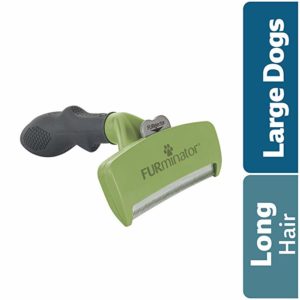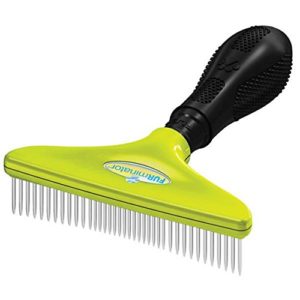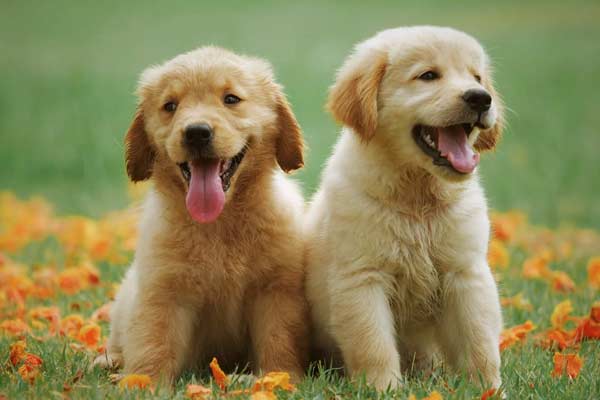Before determining the best dog brush to use in your lab, you should learn more about the breed as a whole. Once you do more research and clearly understand your dog’s breed and how those types of dogs react to certain things, you can take care of them better.
Best Dog Brush for Labs
The best dog brush for labs can penetrate a dense coat. If you use the wrong type of dog brush, only the surface of their fur will brush out, and it is likely that the part closest to the skin will either the mat or become dirty quicker than usual.
The best dog brush for labs is a slicker brush, FURminator, or an undercoat rake for the best results.
The FURminator is the most popular. It is considered one of the top, highest-quality brands of dog brushes. If you’re unsure which brush to get, you can always rely on a FURminator to get the job done correctly.
A high-quality brush will last longer and do a better job at brushing through the fur than a cheap brush. Please don’t allow yourself to settle on something below standard since it will most likely break quickly and have to be replaced.
Here are the best dog brushes for labs.
FURminator Firm Slicker Brush For Dogs

This slicker brush has a long flat surface, so you can brush through a large area of fur faster. One side has curved or bent bristles, the exposed side in the image above; the opposite side has straight bristles.
Use the curved side for detangling and the other for dogs with longer hair, or give the dog’s coat some extra shine.
FURminator for Dogs Undercoat Deshedding Tool

There is more than one type of FURminator. This type works wonders for a dog who constantly sheds. It doesn’t get deep under the fur but pulls off anything loose on the top layer that would have otherwise fallen off in your house.
Hertzko Self-Cleaning Slicker Brush

The Hertzko dog brush stays clean because of its retractable bristles.
After brushing your dog, click the circle button on top of the brush; the bristles retract themselves into the brush base, allowing you to pull off the loose fur in one clean sweep.
Slicker Pro Self-Cleaning Slicker Brush for Dogs and Cats

The Slicker Pro is very similar to the Hertzko dog brush you just read about; both have a self-cleaning feature that is easy to function.
Unless you have a preference for the looks of the dog brush, you may want to try the Hertzko dog brush since it has a higher rating on Amazon, although it has only a .2 higher star rating.
GoPets Dematting Comb-2 Sided Professional Grooming Rake

GoPets makes this great pet comb that can be used as a de-matting brush, an undercoat comb, or a de-shedding rake.
It’s double-sided, with one side with teeth spread apart more than on the other side; this allows for regular brushing and deeper detangling.
Patyourpet 2-Sided Undercoat Rake

This dog brush has two sides as well. You can use it on a dog or a cat, but it works best for dogs, especially those with sensitive skin.
It brushes out tangles easily while gliding gently against the skin, removing dandruff with minimal skin irritation.
FURminator Grooming Rake

FURminator’s grooming rake effectively breaks up mats in the fur and pulls out any dirt or dead skin clumps. Use this in your lab if they like to roll around in the dirt.
Best Dog Brush for Labs Overall
The FURminator is the best dog brush for labs. Buy both the grooming rake and the slicker brush.
You can use the slicker brush for regular grooming and the grooming rake for more severe grooming. To find out what brush works best for your lab’s hair, you may need to try a couple of different types before choosing what to use regularly.
Fur maintenance requirements depend on your dog’s habits and whether they are often outside. Some labs don’t need constant brushing, but most are pretty active and require you to pay lots of attention to their hygiene.
How to Brush Your Labrador
Labrador fur can be tricky to tame; you must buy the best dog brush for labs. They shed a lot; mats develop out of nowhere because of how thick their fur is.
If these mats aren’t dealt with straight away, they will continue to grow until a vast area of the dog’s fur is stuck together.
At that point, your only option is to shave it. As a caring dog owner, you should not let their hygiene get to the end of a necessary shave.
Maintenance will be minimal if you keep up with their hygiene, although the problem is worse if your Labrador has long hair.
The only way to keep your dog’s coat from matting is to brush it weekly. Pay attention to how you are brushing your dog and decide what technique you will use.
Even if you have never owned a dog before, or you just haven’t given much thought to how you brush your dog, it is evident that you should not brush a dog’s coat going in the opposite direction that it lays.
You might not have known that there is more to it than that. Follow the instructions below for proper dog grooming.
Brushing
First, gather your supplies. You will need two dog brushes. The first brush is the leading dog brush you use for detangling and deep grooming, like a pin brush, slicker brush, or rake; whatever you prefer works best on your dog.
The second brush is either a comb or a soft bristle brush that is gentle; this will be used to make your dog’s hair shiny.
If you are able, take your dog outside for grooming. If you must brush them indoors, do it in the bathtub or over a towel. You may want to have a vacuum nearby for stray hairballs.
Start with the pin brush (or the first type of dog brush that you chose). Use it to work through the fur closest to the tail; use short strokes to pull out mats and tangles. Don’t press too hard with the brush, as this will hurt the skin underneath.
If your dog’s fur is in lousy condition, continue with short strokes until you reach the base of its neck.
Otherwise, make long continuous strokes from the neck, down their back, to the base of their tail. Keep brushing with this brush until you are sure all the knots have disappeared.
Finish up with the softer dog brush. Use it to touch the head, legs, tail, back, and belly. Your dog’s fur should start looking smooth and shiny.
It’s unlikely that their hair will stay like this for long, but that’s why you should continue brushing them at least once a week. If you keep up this schedule, their fur will become easier to groom, and less will cover your furniture.
It would help if you did not stray from the once-a-week rule for brushing your dog. Brush them too often, and their skin will dry out and produce dandruff; brush their fur too little, and the amount of shedding will significantly increase.
Types of Dog Brushes
- Slicker brush – A brush that has angled bristles. They are suitable for any dog fur and help with detangling.
- Pin brush – These are for long, smooth dog hair
- Bristle brush – The best type of dog brush for short and wiry fur coats
- Shedding blade – Use one of these on short-haired dogs to remove loose fur and reduce shedding
- Undercoat rake – Long bristles that are spaced out like a comb; they are for dogs with very thick coats
Another type of brush you can use is a FURminator, which is ideal for pups who constantly shed, although you can use one on any dog. FURminator is technically a brand name, not a type of dog brush. There are many types of FURminators.
Labrador Retriever Dog Breed Information
Not all labs are the same; some have thicker or thinner fur due to the characteristics they inherited from their birth parents.
Genetics from a mixed Labrador breed can also drastically impact fur length and thickness, as well as food preferences and dietary requirements.
Size
Labs usually weigh between 55 and 80 lbs and are between 55 and 62cm tall. They are considered a large dog breed, and if your lab is on the heavier side of that scale, especially if they’re an adult male, he is still considered healthy.
You should still be aware of how much your pet weighs and record their weight occasionally to ensure they are in a healthy weight range.
Obesity is common in Labradors, and most are prone to it. Keep a regular exercise schedule for your furry companion so that they stay healthy and live longer. Many playtimes will keep the extra weight off and improve their cardiovascular health.
Animal Planet gives further information online about Labrador Retrievers if you want to read more about their breed.
Nutrition
Labradors live an average lifespan of 10 to 12 years, which is typical for most dog breeds.
However, if your pup wants to live for 12 years, you must keep up with its diet. Treats are okay in moderation but don’t give your dog human food that is greasy or processed, which you can assume consumes a high level of sodium and cholesterol.
Fur coat
Their fur isn’t a typical dog fur coat. Labrador fur is short and thick. It is almost water-repellent because of how dense it is.
It is a double coat, two layers of different types of fur layered on the dog’s skin. The undercoat is soft and fluffy, while the outer coat is coarse and stiff.
The double coat acts as a type of insulation for the dog, eliminating the need for shaving your dog in the summer.
Some dog owners assume that since their dog has a thick coat, they need to shave it off in hotter parts of the year; this is a false idea.
In reality, dogs with double coats are more relaxed with the fur on since the insulation keeps them cool and protects their skin from direct sunlight and UV rays.
Labradors aren’t the only dog breed that has this type of fur. You can also find it on an Akita, an Alaskan Husky, a Shiba Inu, an Australian Shepherd, a Bernese Mountain Dog, and a Sheltie.
Since they have so much fur, expect a lot of shedding. You can significantly reduce the amount of shedding by brushing their fur out at least once a week.
Another way you can keep your lab’s fur clean is by washing it with an all-natural shampoo, but weekly bathing is not necessary.
Constant deep cleaning can cause a dog’s skin to dry out fast. Keep these essential points in mind while considering the best dog brush for your lab.
A happy dog is a healthy dog. It is essential to know your dog’s specific needs and what will keep them in the happiest mood. Do your best to pay attention to your dog’s responses to grooming and eating; this will tell you a lot.

